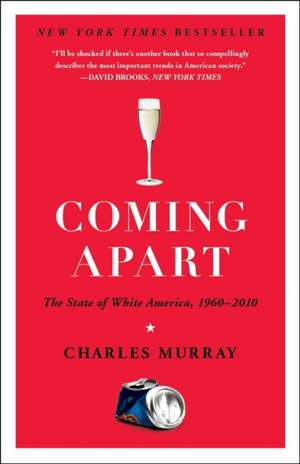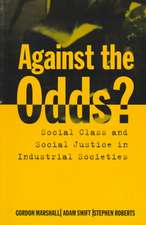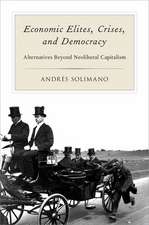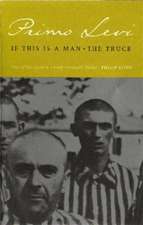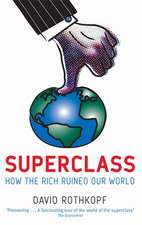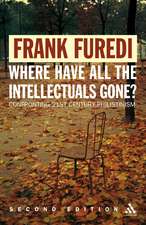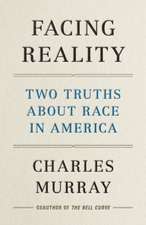Coming Apart
Autor Charles Murrayen Limba Engleză Paperback – 14 ian 2013
In Coming Apart, Charles Murray explores the formation of American classes that are different in kind from anything we have ever known, focusing on whites as a way of driving home the fact that the trends he describes do not break along lines of race or ethnicity.
Drawing on five decades of statistics and research, Coming Apart demonstrates that a new upper class and a new lower class have diverged so far in core behaviors and values that they barely recognize their underlying American kinship—divergence that has nothing to do with income inequality and that has grown during good economic times and bad.
The top and bottom of white America increasingly live in different cultures, Murray argues, with the powerful upper class living in enclaves surrounded by their own kind, ignorant about life in mainstream America, and the lower class suffering from erosions of family and community life that strike at the heart of the pursuit of happiness. That divergence puts the success of the American project at risk.
The evidence in Coming Apart is about white America. Its message is about all of America.
Preț: 79.14 lei
Preț vechi: 94.88 lei
-17% Nou
Puncte Express: 119
Preț estimativ în valută:
15.15€ • 15.73$ • 12.58£
15.15€ • 15.73$ • 12.58£
Carte disponibilă
Livrare economică 11-18 ianuarie 25
Livrare express 31 decembrie 24 - 04 ianuarie 25 pentru 37.88 lei
Preluare comenzi: 021 569.72.76
Specificații
ISBN-13: 9780307453433
ISBN-10: 030745343X
Pagini: 417
Ilustrații: Illustrations
Dimensiuni: 132 x 204 x 22 mm
Greutate: 0.3 kg
Editura: Crown Forum
ISBN-10: 030745343X
Pagini: 417
Ilustrații: Illustrations
Dimensiuni: 132 x 204 x 22 mm
Greutate: 0.3 kg
Editura: Crown Forum
Recenzii
"I’ll be shocked if there’s another book this year as important as Charles Murray’s 'Coming Apart.'”
--David Brooks, The New York Times
"Mr. Murray's sobering portrait is of a nation where millions of people are losing touch with the founding virtues that have long lent American lives purpose, direction and happiness."
--W. Bradford Wilcox, The Wall Street Journal
"'Coming Apart: The State of White America 1960-2010' brims with ideas about what ails America."
-- The Economist
“a timely investigation into a worsening class divide no one can afford to ignore.”
--Publisher's Weekly
“[Charles Murray] argues for the need to focus on what has made the U.S. exceptional beyond its wealth and military power...religion, marriage, industriousness, and morality.”
--Booklist (Starred Review)
"Charles Murray ... has written an incisive, alarming, and hugely frustrating book about the state of American society."
--Roger Lowenstein, Bloomberg Businessweek
--David Brooks, The New York Times
"Mr. Murray's sobering portrait is of a nation where millions of people are losing touch with the founding virtues that have long lent American lives purpose, direction and happiness."
--W. Bradford Wilcox, The Wall Street Journal
"'Coming Apart: The State of White America 1960-2010' brims with ideas about what ails America."
-- The Economist
“a timely investigation into a worsening class divide no one can afford to ignore.”
--Publisher's Weekly
“[Charles Murray] argues for the need to focus on what has made the U.S. exceptional beyond its wealth and military power...religion, marriage, industriousness, and morality.”
--Booklist (Starred Review)
"Charles Murray ... has written an incisive, alarming, and hugely frustrating book about the state of American society."
--Roger Lowenstein, Bloomberg Businessweek
Notă biografică
CHARLES MURRAY is the W. H. Brady Scholar at the American Enterprise Institute. He first came to national attention in 1984 with Losing Ground. His subsequent books include In Pursuit, The Bell Curve (with Richard J. Herrnstein), What It Means to Be a Libertarian, Human Accomplishment, In Our Hands, and Real Education. He received a bachelor’s degree in history from Harvard and a Ph.D. in political science from the Massachusetts Institute of Technology. He lives with his wife in Burkittsville, Maryland.
Cuprins
Prologue: November 21, 1963 1
Part I
The Formation of a New Upper Class
1. Our Kind of People
2. The Foundations of the New Upper Class
3. A New Kind of Segregation
4. How Thick Is Your Bubble?
5. The Bright Side of the New Upper Class
Part II
The Formation of a New Lower Class
6. The Founding Virtues
7. Belmont and Fishtown
8. Marriage
9. Industriousness
10. Honesty
11. Religiosity
12. The Real Fishtown
13. The Size of the New Lower Class
Part III
Why It Matters
14. The Selective Collapse of American Community
15. The Founding Virtues and the Stuff of Life
16. One Nation, Divisible
17. Alternative Futures
Acknowledgments
Appendix A: Data Sources and Presentation
Appendix B: Supplemental Material for the Segregation Chapter
Appendix C: Supplemental Material for the Chapter on Belmont and
Fishtown
Appendix D: Supplemental Material for the Marriage Chapter
Appendix E: Supplemental Material for the Honesty Chapter
Appendix F: Supplemental Material for the American Community
Chapter
Appendix G: Supplemental Material for the Chapter About the Founding
Virtues and the Stuff of Life
Notes
Bibliography
Index
Part I
The Formation of a New Upper Class
1. Our Kind of People
2. The Foundations of the New Upper Class
3. A New Kind of Segregation
4. How Thick Is Your Bubble?
5. The Bright Side of the New Upper Class
Part II
The Formation of a New Lower Class
6. The Founding Virtues
7. Belmont and Fishtown
8. Marriage
9. Industriousness
10. Honesty
11. Religiosity
12. The Real Fishtown
13. The Size of the New Lower Class
Part III
Why It Matters
14. The Selective Collapse of American Community
15. The Founding Virtues and the Stuff of Life
16. One Nation, Divisible
17. Alternative Futures
Acknowledgments
Appendix A: Data Sources and Presentation
Appendix B: Supplemental Material for the Segregation Chapter
Appendix C: Supplemental Material for the Chapter on Belmont and
Fishtown
Appendix D: Supplemental Material for the Marriage Chapter
Appendix E: Supplemental Material for the Honesty Chapter
Appendix F: Supplemental Material for the American Community
Chapter
Appendix G: Supplemental Material for the Chapter About the Founding
Virtues and the Stuff of Life
Notes
Bibliography
Index
Extras
1
Our Kind of People
In which is described the emergence of a new and distinctive culture among a highly influential segment of American society.
ON SEPTEMBER 29, 1987, ABC premiered an hour-long dramatic series with the cryptic title thirtysomething. The opening scene is set in a bar. Not a Cheers bar, where Cliff the mailman perches on a bar stool alongside Norm the accountant and Frasier the psychiatrist, but an airy room, perhaps attached to a restaurant, with sunlight streaming in through paned windows onto off-white walls.
The room is crowded with an upscale clientele gathered for drinks after work, nattily uniformed servers moving among them. Two women in their late twenties or early thirties wearing tailored business outfits are seated at a table. A vase with a minimalist arrangement of irises and forsythia is visible in the background. On the table in front of the women are their drinks- both of them wine, served in classic long-stemmed glasses. Nary a peanut or a pretzel is in sight. One of the women is talking about a man she has started dating. He is attractive, funny, good in bed, she says, but there's a problem: He wears polyester shirts. "Am I allowed to have a relationship with someone who wears polyester shirts?" she asks.
She is Hope Murdoch, the female protagonist. She ends up marrying the man who wore the polyester shirts, who is sartorially correct by the time we see him. Hope went to Princeton. She is a writer who put a promising career on hold when she had a baby. He is Michael Steadman, one of two partners in a fledgling advertising agency in Philadelphia. He went to the University of Pennsylvania (the Ivy League one). Hope and Michael live with their seven-month-old daughter in an apartment with high ceilings, old-fashioned woodwork, and etched-glass windows. Grad-school-like bookcases are untidily crammed with books. An Art Deco poster is on the wall. A Native American blanket is draped over the top of the sofa.
In the remaining forty-five minutes, we get dialogue that includes a reference to left brain/right brain differences and an exchange about evolutionary sexual selection that begins, "You've got a bunch of Australopithecines out on the savanna, right?" The Steadmans buy a $278 baby stroller (1987 dollars). Michael shops for new backpacking gear at a high-end outdoors store, probably REI. No one wears suits at the office. Michael's best friend is a professor at Haverford. Hope breast-feeds her baby in a fashionable restaurant. Hope can't find a babysitter. Three of the four candidates she interviews are too stupid to be left with her child and the other is too Teutonic. Hope refuses to spend a night away from the baby ("I have to be available to her all the time"). Michael drives a car so cool that I couldn't identify the make. All this, in just the first episode.
The culture depicted in thirtysomething had no precedent, with its characters who were educated at elite schools, who discussed intellectually esoteric subjects, and whose sex lives were emotionally complicated and therefore needed to be talked about. The male leads in thirtysomething were on their way up through flair and creativity, not by being organization men. The female leads were conflicted about motherhood and yet obsessively devoted to being state-of-the-art moms. The characters all possessed a sensibility that shuddered equally at Fords and Cadillacs, ranch homes in the suburbs and ponderous mansions, Budweiser and Chivas Regal.
In the years to come, America would get other glimpses of this culture in Mad About You, Ally McBeal, Frasier, and The West Wing, among others, but no show ever focused with the same laser intensity on the culture that thirtysomething depicted-understandably, because the people who live in that culture do not make up much of the audience for network television series, and those who are the core demographic for network television series are not particularly fond of the culture that thirtysomething portrayed. It was the emerging culture of the new upper class.
Let us once again return to November 21, 1963, and try to find its counterpart.
The Baseline
The World of the Upper-Middle Class
Two conditions have to be met before a subculture can spring up within a mainstream culture. First, a sufficient number of people have to possess a distinctive set of tastes and preferences. Second, they have to be able to get together and form a critical mass large enough to shape the local scene. The Amish have managed to do it by achieving local dominance in selected rural areas. In 1963, other kinds of subcultures also existed in parts of the country. Then as now, America's major cities had distinctive urban styles, and so did regions such as Southern California, the Midwest, and the South. But in 1963 there was still no critical mass of the people who would later be called symbolic analysts, the educated class, the creative class, or the cognitive elite.
In the first place, not enough people had college educations to form a critical mass of people with the distinctive tastes and preferences fostered by advanced education. In the American adult population as a whole, just 8 percent had college degrees. Even in neighborhoods filled with managers and professionals, people with college degrees were a minority- just 32 percent of people in those jobs had college degrees in 1963. Only a dozen census tracts in the entire nation had adult populations in which more than 50 percent of the adults had college degrees, and all of them were on or near college campuses.
In the second place, affluence in 1963 meant enough money to afford a somewhat higher standard of living than other people, not a markedly different lifestyle. In 1963, the median family income of people working in managerial occupations and the professions was only $61,500 (2010 dollars, as are all dollar figures from now on). Fewer than 5 percent of American families in 1963 had incomes of $100,000 or more, and fewer than half of 1 percent had incomes of $200,000 or more.
This compressed income distribution was reflected in the residential landscape. In 1963, great mansions were something most Americans saw in the movies, not in person. Only the richest suburbs of New York, Chicago, and Los Angeles had entire neighborhoods consisting of mansions. The nature of the change since then can be seen by driving around suburban neighborhoods where the affluent of the 1960s lived, such as Chevy Chase, Maryland; Belmont, Massachusetts; or Shaker Heights, Ohio. Most of the housing stock remaining from that era looks nothing like the 15,000- and 20,000-square-foot homes built in affluent suburbs over the last few decades. No reproductions of French châteaux. No tennis courts. No three-story cathedral ceilings. Nor were the prices astronomically higher than the prices of middle-class homes. The average price of all new homes built in 1963 was $129,000. The average price of homes in Chevy Chase offered for sale in the classified ads of the Washington Post on the Sunday preceding November 21, 1963, was $272,000, and the most expensive was $567,000. To put it another way, you could live in a typical house in one of the most exclusive neighborhoods in the nation for about twice the average cost of all houses built that year nationwide.
There was a difference between the houses of the upper-middle class and of those who were merely in the middle class. An upper-middle- class home might have four bedrooms instead of two or three, two bathrooms and a powder room instead of one bathroom, and two floors instead of one. It might have a two-car garage, maybe a rec room for the kids and a study for Dad. But it seldom bore any resemblance to a mansion. For an example of elite housing in 1963, download an episode of Mad Men that shows the Drapers' suburban home- that's the kind of house that the creative director of a major New York advertising agency might well have lived in.
The members of the upper-middle-class elite did not have many options for distinguishing themselves by the cars they drove. You could find a few Mercedeses and Jaguars in major cities, but even there they were a pain to keep up, because it was so hard to get spare parts and find a mechanic who could service them. Another factor was at work, too: Executives and professionals in 1963, especially outside New York and Los Angeles, were self-conscious about being seen as show-offs. Many people in the upper-middle class who could have afforded them didn't drive Cadillacs because they were too ostentatious.
Another reason that the lifestyle of the upper-middle class was not dramatically different from that of the middle class was that people who were not wealthy could get access to the top of the line for a lot less in 1963 than in 2010, in the same way that you could live in Chevy Chase for not that much more than you would pay for a house anywhere else. It seems paradoxical from the perspective of 2010. Day- to-day life wasn't cheaper then than it is now. In Washington newspaper advertisements for November 1963, gas was cheaper, at the equivalent of $2.16 per gallon, but a dozen eggs were $3.92, a gallon of milk $3.49, chicken $2.06 a pound, and a sirloin steak $6.80 a pound. The best-selling 1963 Chevy Impala cost about $26,600. At Blum's restaurant in San Francisco, not an expensive restaurant, you paid $12.46 for the hot turkey sandwich, $13.17 for the chef's salad, and $5.34 for the hot fudge sundae. Pearson's liquor store in Washington, DC, had started a wine sale two days earlier, advertising its everyday wines at prices from about $6 to $12. All of these prices would have looked familiar, in some cases a little expensive, to a consumer in 2010.
But the most expensive wasn't necessarily out of reach of the middle class. In 1963, one of the most expensive restaurants in Washington was the newly opened Sans Souci, just a block from the White House and a great favorite of the Kennedy administration. The Washington Post's restaurant critic had a meal of endive salad, poached turbot, chocolate mousse, and coffee for a total of $44.91. The image of a luxury car to Americans in 1963 was a Cadillac. Its most expensive model, the Eldorado Biarritz, listed at $47,000. That same Pearson's advertisement selling vin ordinaire for $6 to $12 offered all the first-growth Bordeaux from the legendary 1959 vintage for about $50 a bottle (yes, I'm still using 2010 dollars).
And so there just wasn't that much difference between the lifestyle of a highly influential attorney or senior executive of a corporation and people who were several rungs down the ladder. Upper-middle-
class men in 1963 drank Jack Daniel's instead of Jim Beam in their highballs and drove Buicks (or perhaps Cadillacs) instead of Chevies. Their suits cost more, but they were all off the rack, and they all looked the same anyway. Their wives had more dress clothes and jewelry than wives in the rest of America, and their hairdressers were more expensive. But just about the only thing that amounted to a major day- to-day lifestyle difference between the upper-middle class and the rest of America was the country club, with its golf course, tennis court, and swimming pool that were closed to the hoi polloi. On the other hand, there were lots of municipal golf courses, tennis courts, and swimming pools, too.
The supreme emblem of wealth in 2010 didn't even exist in 1963. The first private jet, the Learjet Model 23, wouldn't be delivered for another year. Private and corporate planes consisted mostly of Cessnas and Beechcrafts, small and cramped. Only a few hundred large private planes existed, and they were all propeller-driven. The owners of even the poshest of them had to recognize that an economy seat on a commercial DC-8 or Boeing 707 provided a smoother, quieter, and much faster ride.
The World of the Rich
Still, a private plane is a major difference in lifestyle, even if it is not a jet, and private planes did exist in 1963. Shall we look for a distinct upper-class culture among the wealthy?
In 1963, millionaire was synonymous with not just the affluent but the wealthy. A million dollars was serious money even by today's standards, equivalent to about $7.2 million in 2010 dollars. But there were so few millionaires- fewer than 80,000, amounting to two-tenths of 1 percent of American families. The authentically wealthy in 1963 comprised a microscopic fraction of the population.
Some portion of that small number had no distinct preferences and tastes because they had made their money themselves after growing up in middle-class or working-class families. They hadn't gone to college at all, or they had attended the nearest state college. They might live in duplexes on Park Avenue or mansions on Nob Hill, but they were the nouveaux riches. Some acted like the stereotype of the nouveaux riches. Others continued to identify with their roots and lived well but not ostentatiously.
The subset of old-money millionaires did have something resembling a distinct culture. Besides living in a few select neighborhoods, they were concentrated in Boston, New York, and Philadelphia. They summered or wintered in a few select places such as Bar Harbor, Newport, and Palm Beach. They sent their children to a select set of prep schools and then to the Ivy League or the Seven Sisters. Within their enclaves, old-money America formed a distinct social group.
But besides being a tiny group numerically, there was another reason that they did not form an upper-class culture that made any difference to the rest of the nation. Those who hadn't made the money themselves weren't especially able or influential. Ernest Hemingway was right in his supposed exchange with F. Scott Fitzgerald. In 1963, the main difference between the old-money rich and everybody else was mainly that they had more money.
Take, for example, the woman who was the embodiment of the different world of the rich, Marjorie Merriweather Post. Heiress to the founder of the company that became General Foods, one of the wealthiest women in America, she owned palatial homes in Washington, Palm Beach, and on Long Island, furnished with antiques and objets from the castles of Europe. She summered in the Adirondacks, at Camp Topridge, surrounded by her private 207 acres of forest and lakes. She took her sailing vacations on Sea Cloud, the largest privately owned sailing yacht in the world, and flew in her own Vickers Viscount airliner, with a passenger cabin decorated as a living room, probably the largest privately owned aircraft in the world.
Hers was not a life familiar to many other Americans. But, with trivial exceptions, it was different only in the things that money could buy. When her guests assembled for dinner, the men wore black tie, a footman stood behind every chair, the silver was sterling, and the china had gold leaf.
Our Kind of People
In which is described the emergence of a new and distinctive culture among a highly influential segment of American society.
ON SEPTEMBER 29, 1987, ABC premiered an hour-long dramatic series with the cryptic title thirtysomething. The opening scene is set in a bar. Not a Cheers bar, where Cliff the mailman perches on a bar stool alongside Norm the accountant and Frasier the psychiatrist, but an airy room, perhaps attached to a restaurant, with sunlight streaming in through paned windows onto off-white walls.
The room is crowded with an upscale clientele gathered for drinks after work, nattily uniformed servers moving among them. Two women in their late twenties or early thirties wearing tailored business outfits are seated at a table. A vase with a minimalist arrangement of irises and forsythia is visible in the background. On the table in front of the women are their drinks- both of them wine, served in classic long-stemmed glasses. Nary a peanut or a pretzel is in sight. One of the women is talking about a man she has started dating. He is attractive, funny, good in bed, she says, but there's a problem: He wears polyester shirts. "Am I allowed to have a relationship with someone who wears polyester shirts?" she asks.
She is Hope Murdoch, the female protagonist. She ends up marrying the man who wore the polyester shirts, who is sartorially correct by the time we see him. Hope went to Princeton. She is a writer who put a promising career on hold when she had a baby. He is Michael Steadman, one of two partners in a fledgling advertising agency in Philadelphia. He went to the University of Pennsylvania (the Ivy League one). Hope and Michael live with their seven-month-old daughter in an apartment with high ceilings, old-fashioned woodwork, and etched-glass windows. Grad-school-like bookcases are untidily crammed with books. An Art Deco poster is on the wall. A Native American blanket is draped over the top of the sofa.
In the remaining forty-five minutes, we get dialogue that includes a reference to left brain/right brain differences and an exchange about evolutionary sexual selection that begins, "You've got a bunch of Australopithecines out on the savanna, right?" The Steadmans buy a $278 baby stroller (1987 dollars). Michael shops for new backpacking gear at a high-end outdoors store, probably REI. No one wears suits at the office. Michael's best friend is a professor at Haverford. Hope breast-feeds her baby in a fashionable restaurant. Hope can't find a babysitter. Three of the four candidates she interviews are too stupid to be left with her child and the other is too Teutonic. Hope refuses to spend a night away from the baby ("I have to be available to her all the time"). Michael drives a car so cool that I couldn't identify the make. All this, in just the first episode.
The culture depicted in thirtysomething had no precedent, with its characters who were educated at elite schools, who discussed intellectually esoteric subjects, and whose sex lives were emotionally complicated and therefore needed to be talked about. The male leads in thirtysomething were on their way up through flair and creativity, not by being organization men. The female leads were conflicted about motherhood and yet obsessively devoted to being state-of-the-art moms. The characters all possessed a sensibility that shuddered equally at Fords and Cadillacs, ranch homes in the suburbs and ponderous mansions, Budweiser and Chivas Regal.
In the years to come, America would get other glimpses of this culture in Mad About You, Ally McBeal, Frasier, and The West Wing, among others, but no show ever focused with the same laser intensity on the culture that thirtysomething depicted-understandably, because the people who live in that culture do not make up much of the audience for network television series, and those who are the core demographic for network television series are not particularly fond of the culture that thirtysomething portrayed. It was the emerging culture of the new upper class.
Let us once again return to November 21, 1963, and try to find its counterpart.
The Baseline
The World of the Upper-Middle Class
Two conditions have to be met before a subculture can spring up within a mainstream culture. First, a sufficient number of people have to possess a distinctive set of tastes and preferences. Second, they have to be able to get together and form a critical mass large enough to shape the local scene. The Amish have managed to do it by achieving local dominance in selected rural areas. In 1963, other kinds of subcultures also existed in parts of the country. Then as now, America's major cities had distinctive urban styles, and so did regions such as Southern California, the Midwest, and the South. But in 1963 there was still no critical mass of the people who would later be called symbolic analysts, the educated class, the creative class, or the cognitive elite.
In the first place, not enough people had college educations to form a critical mass of people with the distinctive tastes and preferences fostered by advanced education. In the American adult population as a whole, just 8 percent had college degrees. Even in neighborhoods filled with managers and professionals, people with college degrees were a minority- just 32 percent of people in those jobs had college degrees in 1963. Only a dozen census tracts in the entire nation had adult populations in which more than 50 percent of the adults had college degrees, and all of them were on or near college campuses.
In the second place, affluence in 1963 meant enough money to afford a somewhat higher standard of living than other people, not a markedly different lifestyle. In 1963, the median family income of people working in managerial occupations and the professions was only $61,500 (2010 dollars, as are all dollar figures from now on). Fewer than 5 percent of American families in 1963 had incomes of $100,000 or more, and fewer than half of 1 percent had incomes of $200,000 or more.
This compressed income distribution was reflected in the residential landscape. In 1963, great mansions were something most Americans saw in the movies, not in person. Only the richest suburbs of New York, Chicago, and Los Angeles had entire neighborhoods consisting of mansions. The nature of the change since then can be seen by driving around suburban neighborhoods where the affluent of the 1960s lived, such as Chevy Chase, Maryland; Belmont, Massachusetts; or Shaker Heights, Ohio. Most of the housing stock remaining from that era looks nothing like the 15,000- and 20,000-square-foot homes built in affluent suburbs over the last few decades. No reproductions of French châteaux. No tennis courts. No three-story cathedral ceilings. Nor were the prices astronomically higher than the prices of middle-class homes. The average price of all new homes built in 1963 was $129,000. The average price of homes in Chevy Chase offered for sale in the classified ads of the Washington Post on the Sunday preceding November 21, 1963, was $272,000, and the most expensive was $567,000. To put it another way, you could live in a typical house in one of the most exclusive neighborhoods in the nation for about twice the average cost of all houses built that year nationwide.
There was a difference between the houses of the upper-middle class and of those who were merely in the middle class. An upper-middle- class home might have four bedrooms instead of two or three, two bathrooms and a powder room instead of one bathroom, and two floors instead of one. It might have a two-car garage, maybe a rec room for the kids and a study for Dad. But it seldom bore any resemblance to a mansion. For an example of elite housing in 1963, download an episode of Mad Men that shows the Drapers' suburban home- that's the kind of house that the creative director of a major New York advertising agency might well have lived in.
The members of the upper-middle-class elite did not have many options for distinguishing themselves by the cars they drove. You could find a few Mercedeses and Jaguars in major cities, but even there they were a pain to keep up, because it was so hard to get spare parts and find a mechanic who could service them. Another factor was at work, too: Executives and professionals in 1963, especially outside New York and Los Angeles, were self-conscious about being seen as show-offs. Many people in the upper-middle class who could have afforded them didn't drive Cadillacs because they were too ostentatious.
Another reason that the lifestyle of the upper-middle class was not dramatically different from that of the middle class was that people who were not wealthy could get access to the top of the line for a lot less in 1963 than in 2010, in the same way that you could live in Chevy Chase for not that much more than you would pay for a house anywhere else. It seems paradoxical from the perspective of 2010. Day- to-day life wasn't cheaper then than it is now. In Washington newspaper advertisements for November 1963, gas was cheaper, at the equivalent of $2.16 per gallon, but a dozen eggs were $3.92, a gallon of milk $3.49, chicken $2.06 a pound, and a sirloin steak $6.80 a pound. The best-selling 1963 Chevy Impala cost about $26,600. At Blum's restaurant in San Francisco, not an expensive restaurant, you paid $12.46 for the hot turkey sandwich, $13.17 for the chef's salad, and $5.34 for the hot fudge sundae. Pearson's liquor store in Washington, DC, had started a wine sale two days earlier, advertising its everyday wines at prices from about $6 to $12. All of these prices would have looked familiar, in some cases a little expensive, to a consumer in 2010.
But the most expensive wasn't necessarily out of reach of the middle class. In 1963, one of the most expensive restaurants in Washington was the newly opened Sans Souci, just a block from the White House and a great favorite of the Kennedy administration. The Washington Post's restaurant critic had a meal of endive salad, poached turbot, chocolate mousse, and coffee for a total of $44.91. The image of a luxury car to Americans in 1963 was a Cadillac. Its most expensive model, the Eldorado Biarritz, listed at $47,000. That same Pearson's advertisement selling vin ordinaire for $6 to $12 offered all the first-growth Bordeaux from the legendary 1959 vintage for about $50 a bottle (yes, I'm still using 2010 dollars).
And so there just wasn't that much difference between the lifestyle of a highly influential attorney or senior executive of a corporation and people who were several rungs down the ladder. Upper-middle-
class men in 1963 drank Jack Daniel's instead of Jim Beam in their highballs and drove Buicks (or perhaps Cadillacs) instead of Chevies. Their suits cost more, but they were all off the rack, and they all looked the same anyway. Their wives had more dress clothes and jewelry than wives in the rest of America, and their hairdressers were more expensive. But just about the only thing that amounted to a major day- to-day lifestyle difference between the upper-middle class and the rest of America was the country club, with its golf course, tennis court, and swimming pool that were closed to the hoi polloi. On the other hand, there were lots of municipal golf courses, tennis courts, and swimming pools, too.
The supreme emblem of wealth in 2010 didn't even exist in 1963. The first private jet, the Learjet Model 23, wouldn't be delivered for another year. Private and corporate planes consisted mostly of Cessnas and Beechcrafts, small and cramped. Only a few hundred large private planes existed, and they were all propeller-driven. The owners of even the poshest of them had to recognize that an economy seat on a commercial DC-8 or Boeing 707 provided a smoother, quieter, and much faster ride.
The World of the Rich
Still, a private plane is a major difference in lifestyle, even if it is not a jet, and private planes did exist in 1963. Shall we look for a distinct upper-class culture among the wealthy?
In 1963, millionaire was synonymous with not just the affluent but the wealthy. A million dollars was serious money even by today's standards, equivalent to about $7.2 million in 2010 dollars. But there were so few millionaires- fewer than 80,000, amounting to two-tenths of 1 percent of American families. The authentically wealthy in 1963 comprised a microscopic fraction of the population.
Some portion of that small number had no distinct preferences and tastes because they had made their money themselves after growing up in middle-class or working-class families. They hadn't gone to college at all, or they had attended the nearest state college. They might live in duplexes on Park Avenue or mansions on Nob Hill, but they were the nouveaux riches. Some acted like the stereotype of the nouveaux riches. Others continued to identify with their roots and lived well but not ostentatiously.
The subset of old-money millionaires did have something resembling a distinct culture. Besides living in a few select neighborhoods, they were concentrated in Boston, New York, and Philadelphia. They summered or wintered in a few select places such as Bar Harbor, Newport, and Palm Beach. They sent their children to a select set of prep schools and then to the Ivy League or the Seven Sisters. Within their enclaves, old-money America formed a distinct social group.
But besides being a tiny group numerically, there was another reason that they did not form an upper-class culture that made any difference to the rest of the nation. Those who hadn't made the money themselves weren't especially able or influential. Ernest Hemingway was right in his supposed exchange with F. Scott Fitzgerald. In 1963, the main difference between the old-money rich and everybody else was mainly that they had more money.
Take, for example, the woman who was the embodiment of the different world of the rich, Marjorie Merriweather Post. Heiress to the founder of the company that became General Foods, one of the wealthiest women in America, she owned palatial homes in Washington, Palm Beach, and on Long Island, furnished with antiques and objets from the castles of Europe. She summered in the Adirondacks, at Camp Topridge, surrounded by her private 207 acres of forest and lakes. She took her sailing vacations on Sea Cloud, the largest privately owned sailing yacht in the world, and flew in her own Vickers Viscount airliner, with a passenger cabin decorated as a living room, probably the largest privately owned aircraft in the world.
Hers was not a life familiar to many other Americans. But, with trivial exceptions, it was different only in the things that money could buy. When her guests assembled for dinner, the men wore black tie, a footman stood behind every chair, the silver was sterling, and the china had gold leaf.
